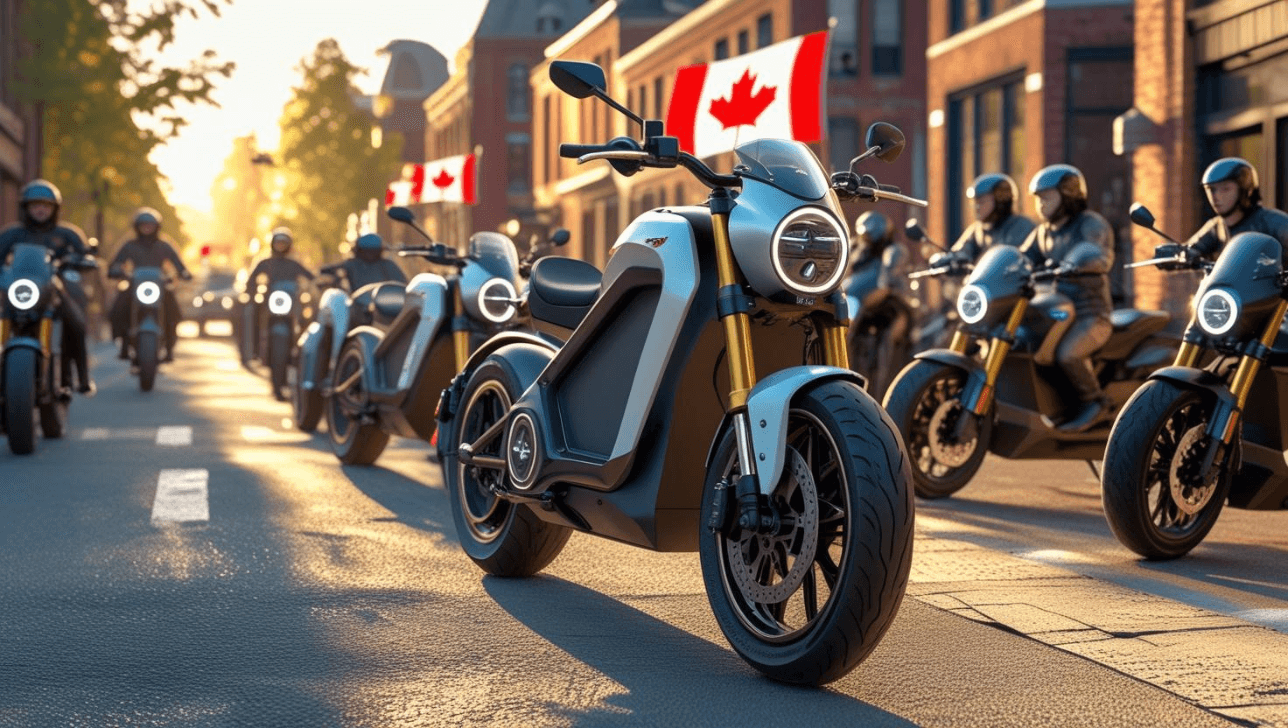Electric Motorcycles in Canada
Are They Worth the Hype?
Electric motorcycles are rapidly emerging as the next frontier of two-wheeled transportation. They’re quieter, sleeker, and more environment friendly compared to their gasoline counterparts, which makes them appealing to a significant number of motorcycle riders.

In fact, the Canadian government is committed to phasing out light-duty internal combustion vehicle sales over the next decade. This means we’re going to have more electric motorcycles on the road over the next few years than ever before.
However, as electric motorcycles are slowly gaining traction, one question remains: Are electric motorcycles in Canada worth the hype? In this article, we’ll explore everything you need to know about the state of electric motorcycles in Canada and whether now is the right time to go electric on two wheels. Let’s jump right in!
Which Electric Motorcycle Brands Are Available in Canada?
There are over a dozen electric motorcycle brands in Canada that sell different types of motorcycles. Some of the most popular e-motorcycle brands in Canada include LiveWire (Harley-Davidson), Emmo, Joule Motorcycles, Zero Motorcycles, Energica, and Can-Am. Other notable brands include the Sur-Ron, Damon Motorcycles, and BMW CE 04.
At the moment, we’re yet to have as many e-motorcycle brands and varieties on the market in Canada as gasoline-powered motorcycle brands. However, as Canada phases out gasoline-powered motorcycles over the next decade, more traditional brands are expected to transition to electric motorcycles.
What’s The Range of Most E-Motorcycles in Canada?
The range for most e-motorcycles in Canada is between 80 and 150 miles. Unfortunately, with that electric range, it may be challenging to go on a long-distance tour across Canada — but it’s possible if you take advantage of Canada’s wide charging network. That aside, the range of an e-motorcycle isn’t written in stone and it can fluctuate depending on factors such as the weather, speed, rider weight, terrain, and battery condition.
On the other hand, if you would prefer a motorcycle for urban commuting in Canada, an electric option would be convenient considering you will have plenty of charging stations in the cities.
How Long Does It Take to Charge Your E-Motorcycle in Canada?
The time it takes to charge an electric motorcycle varies based on the type of charger used. With a Level 1 charging system that connects to a standard household outlet, it can take anywhere from 6 to 24 hours to fully charge the battery. In contrast, using a Level 2 public charger can reduce the charging time to less than 4 hours.
Beyond that, if you use a Level 3 DC fast charger, it could take you as little as half an hour. The only problem is that you will find a lower number of Level 3 DC fast chargers compared to Level 2 chargers which are more popular.
But unlike electric cars, it’s possible to swap your depleted e-motorcycle battery for a fully charged unit in less than five minutes. Unfortunately, battery swapping stations haven’t peaked in Canada — but you can swap the battery at home.
How Much Would It Cost to Buy an Electric Motorcycle in Canada?
How much you will likely spend to buy a motorcycle in Canada will depend on the brand and the specific model. However, most e-motorcycles on the Canadian market start at a price tag of 3,000 CAD with the high-end models costing as much as 50,000 CAD.
In comparison, electric motorcycles are slightly more expensive than gasoline-powered motorcycles in Canada. But on the flip side, e-motorcycles are cheaper to fuel and maintain than gas-powered motorcycles.
How Much Would It Cost to Insure an Electric Motorcycle in Canada?
It would typically cost you between \$900 and \$3,000 to insure an electric motorcycle in Canada. There isn’t much of a difference in the cost to insure an e-motorcycle and a gas-powered motorcycle in Canada since the annual premium is mostly calculated based on age, riding experience, driving record, performance, and price tag.
However, some insurance companies have slightly higher rates for electric motorcycles because damaged batteries are expensive to replace. Not to mention, electric motorcycles tend to be more expensive to repair than gas-powered motorcycles. On the other hand, some insurance companies don’t include the battery pack under the collision policy but instead require a special add-on to cover the battery. Because of that, make sure you clarify the battery is insured before you sign up for any insurance policy.
There Is a Long Way to Go Before E-Motorcycles Are Fully Adopted
There are many advantages e-motorcycles offer over gas-powered motorcycles. To be more specific, they offer faster acceleration, lower maintenance costs, quieter rides, and zero emissions. However, there is still much to improve before electric motorcycles are adopted in Canada. Top of that list is expanding the charging infrastructure in Canada and hopefully, e-motorcycle manufacturers will find a way to increase the range significantly.
For now, gas-powered motorcycles remain the better choice for long-distance travel in Canada. That said, electric motorcycles offer greater convenience for urban commuting—and it may only be a matter of time before they match gas-powered bikes in long-distance capability.
